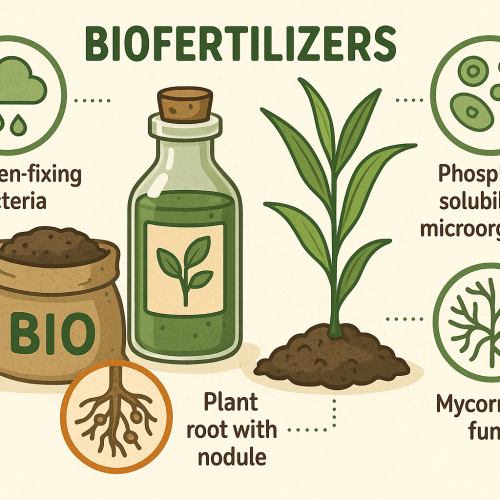Modern agriculture is shifting towards eco-friendly and sustainable practices. Among these, biofertilizers are gaining popularity as they improve soil fertility, promote plant growth, and reduce chemical fertilizer dependency. But what are biofertilizers, what types are available, and how can they be applied in farming? Let’s explore.
What are Biofertilizers?
Biofertilizers are living microorganisms that enhance the availability of nutrients in the soil. Unlike chemical fertilizers, they are natural, cost-effective, and improve soil health in the long run.
👉 In simple terms, biofertilizers help crops absorb nitrogen, phosphorus, and other nutrients more efficiently.
Types of Biofertilizers
1. Nitrogen-Fixing Biofertilizers
-
Examples: Rhizobium, Azotobacter, Azospirillum, Blue-green algae
-
Function: Fix atmospheric nitrogen and make it available to plants.
-
Best For: Legumes, cereals, and vegetable crops.
2. Phosphate-Solubilizing Biofertilizers (PSB)
-
Examples: Bacillus, Pseudomonas species
-
Function: Convert insoluble phosphates into soluble forms for plant absorption.
-
Best For: Wheat, rice, maize, sugarcane.
3. Potassium-Mobilizing Biofertilizers
-
Examples: Frateuria aurantia
-
Function: Mobilize potassium from the soil and enhance root development.
-
Best For: Paddy, sugarcane, vegetables, fruits.
4. Mycorrhizal Biofertilizers
-
Examples: Vesicular-Arbuscular Mycorrhiza (VAM)
-
Function: Improve nutrient uptake, water absorption, and plant resistance.
-
Best For: Horticultural crops, forestry, ornamental plants.
5. Cyanobacteria & Blue-Green Algae (BGA)
-
Examples: Anabaena, Nostoc
-
Function: Fix nitrogen and improve soil fertility in rice fields.
-
Best For: Paddy cultivation.
6. Zinc & Sulphur-Solubilizing Biofertilizers
-
Function: Make micronutrients like zinc and sulphur available to crops.
-
Best For: Oilseeds, pulses, cereals.
| S.N | Groups | Examples |
|---|---|---|
| A | N₂ Fixing Biofertilizer | |
| 1. | Free-living | Azotobacter, Clostridium, Anabaena, Nostoc |
| 2. | Symbiotic | Rhizobium, Anabaena azollae |
| 3. | Associative Symbiotic | Azospirillum |
| B | P Solubilizing Biofertilizer | |
| 1. | Bacteria | Bacillus subtilis, Pseudomonas striata |
| 2. | Fungi | Penicillium sp., Aspergillus awamori |
| C | P Mobilizing Biofertilizers | |
| 1. | Arbuscular Mycorrhiza | Glomus sp., Scutellospora sp. |
| 2. | Ectomycorrhiza | Laccaria sp., Pisolithus sp., Boletus sp., Amanita sp. |
| 3. | Ericoid Mycorrhiza | Pezizella ericae |
| D | Biofertilizer for Micro Nutrients | |
| 1. | Silicate and Zinc solubilizers | Bacillus sp. |
| E | Plant Growth Promoting Rhizobacteria | |
| 1. | Pseudomonas | Pseudomonas fluorescens |
Benefits of Biofertilizers
✅ Improve soil fertility naturally
✅ Reduce chemical fertilizer dependency
✅ Enhance crop yield & quality
✅ Environmentally safe & sustainable
✅ Cost-effective solution for farmers
Application of Biofertilizers in Agriculture
-
Seed Treatment
-
Mix biofertilizer culture with seeds before sowing.
-
Ensures early root colonization.
-
-
Soil Application
-
Mix biofertilizers with compost or farmyard manure.
-
Apply directly to the field before sowing.
-
-
Seedling Root Dipping
-
Dip plant roots (e.g., rice, vegetables) in biofertilizer slurry before transplanting.
-
-
Foliar Spray
-
Spray liquid biofertilizers on crop leaves for direct nutrient absorption.
-
Best Practices for Using Biofertilizers
-
Store them in a cool, dry place (avoid direct sunlight).
-
Use before the expiry date (usually 6–12 months).
-
Combine with organic manures for better results.
-
Avoid mixing with chemical fertilizers or pesticides.
Conclusion
Biofertilizers are a game-changer for sustainable agriculture. By improving soil fertility and reducing chemical dependency, they not only benefit farmers but also protect the environment. With proper application, biofertilizers can significantly boost crop yield and promote long-term soil health.
👉 If you are a farmer or agripreneur, switching to biofertilizers could be your first step towards eco-friendly farming and higher profits.







